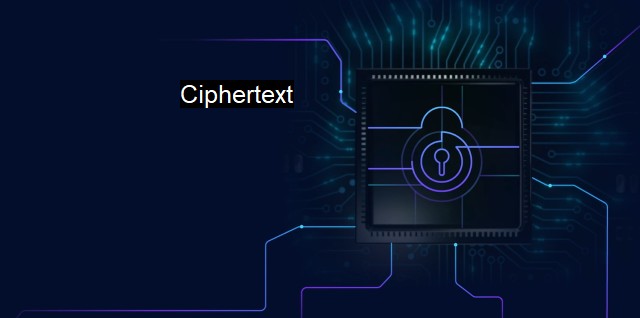What is Ciphertext?
Exploring the Significance of Ciphertext: An Essential Element in Encryption and Cybersecurity
In the realm of cybersecurity and antivirus software—fields built upon the protection, integrity, and confidentiality of our digital information—the concept of ciphertext holds a central position. Ciphertext is essentially a form of text which has been scrambled from its original, readable version—known as plaintext—into a coded version that can't be understood without decryption. The variety of techniques used to transform plaintext into ciphertext is collectively known as encryption.Ciphertext emerges when an encryption algorithm—referred to mundanely as a cipher—is applied to plaintext. The conversion process requires a key—a strict and classified series of instructions used to guide the encryption. Ciphers themselves are complex mathematical algorithms that carry out the intricate procedures for encryption and their resulting output is the ciphertext. It could appear as an ensemble of arbitrary symbols, numerical digits, or additional text that bears no intelligible correlation with the original message.
The discipline of protecting text via encryption stretches back to ancient times, predating even the word "ciphertext". Kings, generals and top-level officials would send commands and sensitive information encrypted in simple ciphers to escape the eyes of their enemies, providing a firm foundation for the ciphers we use today. Modern encryption techniques have exponentially advanced beyond these historical methods, giving rise to extremely potent ciphers that refrain even the most sophisticated cyber attackers from unscrambling the ciphertext.
In the contemporary world, our lives are increasingly interconnected and rely heavily on technology. From personal communications and financial transactions to critical infrastructures and national secrets, hundreds of billions of data are shared globally, all susceptible to cyber-attacks. Prominent threats include data theft, espionage, ransomware attacks, and the exposure of sensitive information. Ciphertext—commissioned through the dynamic artistry of encryption—is an omnipresent shield that defends our digital universe from these hazards virtually every moment of our lives.
In the domain of antivirus software, ciphertext furnishes an instrumental role. Malware—an umbrella term for all forms of malicious software, including viruses, ransomware, and trojans—is notably designed to stage attacks by exploiting vulnerabilities in a system's security frameworks. The malware leverages these security gaps to inflict damage by unauthorized access, manipulation or theft of data, injecting intrusive ads or oftentimes, taking entire systems hostage.
Antivirus software identifies, quarantines, and eliminates malware to protect systems and their data. This protective software utilizes encryption as a key strategy in its defensive repertoire to safeguard data. For instance, when an antivirus scans a system, any collected sensitive data, such as personal or financial information, is encrypted into ciphertext prior to transmission to ensure its content is safe from unauthorized access or hazardous interceptions 'en route'.
Antivirus software doesn't merely defend from incoming threats, it also sheathes outbound data—a computer's inset traffic—in layers of encryption, transforming the data into ciphertext. This nullifies the risk of sensitive data being ambushed and hijacked while traversing the internet—the cybersecurity equivalent of shark-infested waters.
Encryption mitigates against advanced forms of cyber attacks, such as Man-in-The-Middle (MitM) attacks, where attackers sneak in between communication paths, attempting to secretly intercept and steal data flowing en-route. Since the transferred data is commonly wrapped in the guise of an enigmatic ciphertext, it becomes practically pointless for the attacker to gain access.
So, crucially put, 'Ciphertext' forms the technological bedrock of cybersecurity and antivirus protection. It's the chosen language of professional encryption—the fail-safe method defending sensitive systems against a crawling array of insidious digital threats. Without the correct keys for decryption, the convoluted and indecipherable nature of ciphertext defies unauthorized users, rendering deciphered messages as enigmatic as an untold tale. As we continue to weave our digital lives into shared and accessible spaces, trust in the security that ciphertext grants is not just valuable, it is indispensable.

Ciphertext FAQs
What is ciphertext in cybersecurity?
Ciphertext is encrypted text that has been scrambled or transformed using a mathematical algorithm. It is used to secure sensitive information to prevent unauthorized access or interception.How is ciphertext different from plaintext?
Plaintext is the original unencrypted message, while ciphertext is the scrambled or encrypted version of the message. Ciphertext is used to protect the confidentiality of the information and prevent it from being read or understood by unauthorized individuals.Can antivirus software detect ciphertext?
Antivirus software can detect and analyze ciphertext, but it cannot read or decipher it without the appropriate decryption key. However, antivirus software can identify and block malware that uses ciphertext to hide its malicious code.Is ciphertext always secure?
Ciphertext can be secure if it is encrypted using a strong encryption algorithm and a secure key. However, if the encryption algorithm or key is compromised, ciphertext can be decrypted and the information it protects can be exposed.| | A | | | B | | | C | | | D | | | E | | | F | | | G | | | H | | | I | | | J | | | K | | | L | | | M | |
| | N | | | O | | | P | | | Q | | | R | | | S | | | T | | | U | | | V | | | W | | | X | | | Y | | | Z | |
| | 1 | | | 2 | | | 3 | | | 4 | | | 7 | | | 8 | | |||||||